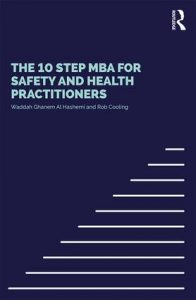Book publisher Routledge has recently released books about occupational health and safety (OHS) that are very critical of OHS’ role, or that of the health and safety professional, in modern business. Below I dip into the
- The Fearless World of Professional Safety in the 21st Century
- The 10 Step MBA for Safety and Health Practitioners, and
- Naked Safety – Exploring The Dynamics of Safety in a Fast-Changing World.
 Scott Gesinger‘s book “The Fearless World of Professional Safety in the 21st Century” has a strong United States of America tone which can be grating and distracts from some of the excellent points he is making. In fact he talks about the importance of distraction as a hazard in one of his short chapters. He talks about DAF, what he describes as the “Darwin Award Factor”, where a worker will do something wrong and writes:
Scott Gesinger‘s book “The Fearless World of Professional Safety in the 21st Century” has a strong United States of America tone which can be grating and distracts from some of the excellent points he is making. In fact he talks about the importance of distraction as a hazard in one of his short chapters. He talks about DAF, what he describes as the “Darwin Award Factor”, where a worker will do something wrong and writes:
“DAF is a mental error, oftentimes accentuated by distraction. A huge issue that is becoming apparent in safety is distraction due to devices. The more connected people are the more their mental faculties will be focused on social connections…. Our challenge as safety professionals is working around those behaviours in order to continue providing a safe workplace while not alienating the young workforce.” (page 133)
I am not sure about this. “Mental error” reminds me of “human error” and this reminds me of “blaming the worker”. I am not saying that workers are blameless but I am also not sure that we should be “working around these behaviours” rather than examining the design of the work task, work environment and the social connection device. Shouldn’t we be looking at integrating the behaviour into workplace productivity?
Gesinger changes the format of most of one chapter into an imagined debate over different safety management systems, contrasting Deming to Heinrich. This willingness to break up the tone is a great move supported by the use of text boxes that read like marginalia or Deadpool breaking the fourth wall.
His chapter of behaviour-based safety (BBS) is very good, even though I don’t like cats, but I would be less supportive of E Scott Geller. I attended one of his seminars in Melbourne around ten or fifteen years ago. At the first available break, many in the audience walked out. His message, his references and manner grated with the Australian audience, myself included. The person who invited me to the seminar apologised for wasting my time. Perhaps Geller is one of those people from whom you gain more benefit from their writings than their presentations
I agree with Gesinger that
“BBS can add value when used a bit differently than most of the people who sell it advise” (page 43)
Many of those sellers carry an arrogance, air of superiority and inflated ego that limits the application of the bits of BBS that could have long-term benefit.
Looking again at Gesinger’s book for this article I was reminded of the power in the last paragraphs of each chapter. He wraps up the chapters’ topics really well to the point that you can refresh yourself on his thoughts by reading just these paragraphs on a regular basis.
 I bought The 10 Step MBA for Safety and Health Practitioners
I bought The 10 Step MBA for Safety and Health Practitioners
by Waddah S Ghanem Al Hashmi, and Rob Cooling because OHS professionals are constantly being advised to talk about safety in a language that the senior executives and Boards understanding, and I thought this book might help.
I am really enjoying this book as provides me with an insight into the C-Suite without having to pay for a Masters of Business Administration (MBA) and even if enrolled in that course OHS is unlikely to be featured. The authors pick just the right tone for imparting information without sounding patronising or causing the reader to have a business dictionary or a thesaurus with them.
The book is also as current as a published book can be. The Preface was written in October 2017 allowing the book to be one of the first to spend some time talking about the role and impact of the latest Standard for OHS Management Systems – ISO45001, which is a major advantage. Even though the Standard was not finalised in October, the elements of Leadership and Commitment were developed enough for the authors to discuss.
As well as discussion, tips are included, not the extent seen in a Dummies guide but serve the same function, and are different from Gesinger’s asides. For instance, on defining OSH leadership behaviours, the authors suggest:
“…why not ask top management in the organisation what they believe to be the qualities of great leaders. In many cases, there will be commonalities between characteristics of great leadership and great OSH leadership. This way you will be able to arrive at an inventory of OSH leadership behaviours that are bred within the organisation, which will ultimately assist with ownership and implementation of any proposed approach.” (page 29)
The authors also touch on the “Safety Culture Maturity Model”, in passing, noting that the phrase is now a registered trademark of the Keil Centre Limited. They are able to draw in the advice on developing an OHS culture from the Health and Safety Executive and the context of behaviour-Based Safety (BBS) programs. They say this about the combination:
“…the growing recognition that improving OSH performance requires a focus on shaping of workplace behaviours has led to a proliferation of Behaviour Based Safety programs, particularly in the major hazard industries. However, it is important that your organisation has the right level of maturity for a behaviour based approach. Importantly, you need to get the basics right, in terms of technical and administrative controls, before you spend too much time looking at behaviour.” (page 57, emphasis added)
POW and Hallelujah! “Get the basics right”. The next generation of OHS professionals should realise that becoming a National General Manager of HSE is a worthy ambition but there remains a career in teaching and enforcing the basics, and the reapplication of OHS basics to the next wave or generation of workers. Many OHS professionals have already noticed an intolerance in young workers to being spoken to in a manner that some would describe as “traditional”, others “character building”. Young workers are less likely to accept work that involves unnecessary hardship – why lift when we are supposed to provide trolleys?, why work alone without, at least, some sort of electronic monitoring?, Why inspect the plumbing under a house when we can use a camera?, Why work on a ladder when we can use a small personnel lift? ….
These are examples of the OHS basics that are expected by new and young workers. They illustrate that basics are evolving all the time. Some of us would acknowledge this is, or is a consequence of, continuous improvement, which is both a legislative requirement and a successful business sustainability strategy.
Having mentioned sustainability, the authors write that:
“… sustainability and business now go hand-in-hand, with sustainability regarded as a far-reaching subject, addressing economic, social and financial considerations that relate to the ability of an organisation to deliver value.” ( page 40)
It’s a good way to think of one’s OHS obligations and the social context of those obligations.
This 10 Step MBA is terrific and won’t take long to read but will require a lot of time to digest in one’s own context. Someone needs to organise for either, or both, Waddah S Ghanem Al Hashmi and Rob Cooling to feature in Australian and New Zealand OHS and business conferences over the next 18 months.
 The last book from Routledge is due for publication until July 24 2018 but the abstract to Naked Safety – Exploring The Dynamics of Safety in a Fast-Changing World sounds like it is another of those books that challenge the OHS discipline and may jolt it out of its complacency and comfort. The author, Andrew Sharman, has now written a couple of books related to safety and has a TEDx talk about our culture of fear.
The last book from Routledge is due for publication until July 24 2018 but the abstract to Naked Safety – Exploring The Dynamics of Safety in a Fast-Changing World sounds like it is another of those books that challenge the OHS discipline and may jolt it out of its complacency and comfort. The author, Andrew Sharman, has now written a couple of books related to safety and has a TEDx talk about our culture of fear.
The reviews of the book by people like Judith Hackitt are solid or glowing and the blurb says:
“To change the game and build real risk literacy, it’s vital to make things easier, to strip things back to basics and think again about how we work. This is Naked Safety.”
Andrew Hopkins is particularly praiseworthy of the book’s “knockout first chapter”. The publishers obviously knew who to send preview copies to.
From the topics listed in his new book and his measured manner seen in his TEDx talk, this book looks like it will give serious, but not ponderous, consideration to health and safety, regardless of the provocative marketing tile of “Naked Safety”. It is hoped that the book is based on evidence rather than speculation but if it spurs uncomfortable discussions, it could be another book on the OHS Professional’s List of Essential Books (even it is only available in hardback with a price of over A$100!).
